Ange’s coming back to Rokkenjima!
But first, responding to some reader comments:
Reuel: Congratulations on your ressurection. Glad to see the let’s read back. As someone who also took years long breaks from Umineko I’m curious do you think there is anything about Umineko that made you lose interest at these specific points?
Thanks, it’s good to do this again.
I think for me it’s basically less the VN itself and more just my ADHD attention pattern. I tend to live in a way where I really hyperfocus on something for a while… and then my obsessive interest burns out, or something else displaces it, and then that thing falls into the “I’ll get around to it in a bit” pile, and then gradually slides out of medium-term memory unless something happens to remind me of it. Similar things happen to other projects all the time: for example, I have procrastinated more than a year on working on the sequel to The Tale of the Little Witch.
More on that
Most of the time, it simply does not occur to me to do one of these ‘backburner’ things, since other things are filling my attention (this time it was mainly gamedev and the demoscene), and I plain don’t realise how much time has passed because I’m just not thinking about it at all. If something can be done in one of those hyperfocus windows, I can do amazing things… if not, well, we’re in trouble! It is like there is an ‘energy barrier’ to getting back into that state, so when I do think about it, I remember (for example) the effort it takes to edit all those damn screenshots, and so it has a sort of ‘nah I don’t feel like it right now’ energy.
It takes a fair bit of effort to liveblog the longer chapters of Umineko, so the ‘barrier to getting going’ is quite high. This was even more true for the original five-year hiatus, because I had to reread the entire story to get back up to speed on what was going on. This time I remembered the story well enough to just settle in right where I left off.
But yeah, I think I tend to end up on hiatus after particularly big and involved chapters, just because it takes the most effort to write them up, so that makes my perception of ‘how much energy it will take to pick up Umineko’ more daunting. It’s not even that I was not interested! At the end of chapter 13, I really wanted to know what would happen and where this was all going. Just, my perfectionism got in the way. So I had to compromise on that a bit: for example, I don’t meticulously ruby-text romaji for every Japanese quote anymore. (It’s probably easier to read for non-Japanese readers this way, anyway.)
(Ironically, I think trying to hack the OnScripter program to automate scaling, cropping and describing the screenshots, even though I failed, was actually quite useful for me. Because that got me into a ‘thinking about Umineko’ state, and that made the bridge to ‘liveblog more of it’ more viable. And it led me to think about other approaches which could make it easier without requiring a custom fork, like copypasting text from the script.)
Zasis: heyyy missed you!!!! so unexpected to see you, hehe, but i’m very glad! i’m very enjoying your umi blogging ♥️
Thanks, appreciate it a lot! I am really grateful for all the love shown to this liveblog by Umineko fans over the years, and for still coming back after all this time, you’re the best. And yeah, strange twist of fate that I ended up back here. But hey, it’s proving grounding, so let’s keep at it.
Ange is on a boat, going to Rokkenjima! The chapter opens with a jazz piece in the soundtrack, which turns out to be diegetic music being played by Asakusa on the radio. Asakusa says “You don’t like M. Zakky?” in a cheeky nod to the game’s actual composer.
She hears the famous cries of the ‘umineko’ seagulls, unlike everyone who did not survive the typhoon. They pass the ruins of a harbour that would have been used at the time of the incident—it has since been abandoned, and there is a second, hidden harbour which they now approach—a harbour that presumably connects to Kuwadorian.
Kawabata notes that the people who knew about the second harbour are limited to Kinzo, Genji, Kumasawa, Nanjo, ‘those of us involved with the boats’, and ‘a very small number of the oldest servants’. Kawabata himself was not allowed to come ashore at Kuwadorian. He does note that he carried ‘stuff only women would use’ over to Kuwadorian, lending credence to the idea that Beatrice was imprisoned there. But he never personally saw her in 20 years. He also says that ‘one day’, trips to Kuwadorian abruptly stopped, around 1968. At the time, it was pretty evident from everyone’s reactions that the resident of Kuwadorian had died.
So timeline: original!Beatrice dies in 1968. The murders happen in 1986. Battler is 18 at the time of the Rokkenjima incident, so he would be born… 1967-8, actually, curious coincidence. The ‘sin’ must have happened around 1980. Ange was six at the time of the Rokkenjima incident, so her birth also corresponds to a significant event in the timeline. Well, that adds up, because six years ago is supposed to be when Battler started rejecting Rudolf, which would have been when Rudolf’s affair with Kyrie was discovered, so yeah, since the ‘sin’ coincides with that, that would be when Ange was born.
Still, according to our Battler (who may be an imposter!), Ange treated him like a big brother… well, I’m fairly sure Ange also said she has memories of him? Yes: in the liveblog of chapter 2, I wrote…
This prompts Ange to think back to her own birthdays. Rudolf would make a point of coming home briefly from work, and Kyrie would be an expert present-giver. Honestly, of all the Ushiromiya parents, they seem to be easily the most chill. Battler would show up only sometimes, still angry with Rudolf.
And in chapter 7 Ange interacts onscreen with Battler in a flashback scene. So Ange did meet some version of Battler in the time between his ‘sin’ and the Rokkenjima incident. Two ways to interpret this:
- Rudolf’s claimed ‘body double’ scheme began a whole lot earlier; ‘Battler is angry with the family’ is a coverup for the fact that he was killed in 1980, meaning Rudolf must be one of the killers. (Unclear if Kyrie was in on it.)
- Battler only metaphorically ‘died’ at the time of the ‘sin’, or else Beatrice is mistaken in asserting that he died in 1980. (She did not assert this in red!)
At this point we don’t have enough information to draw any further conclusions. That said, I think ‘Battler is a body double sent by Rudolf’ is the wrong sort of weird and left-field to really fit the story. So, I think Beatrice is either mistaken or not telling us the whole truth here.
According to the official narrative, Eva escaped the ‘accident’ by virtue of being in Kuwadorian at the time. Ange questions why she’d possibly go there, if it was abandoned. Kawabata says she should never have so much as known it existed. It would also have been near impossible to get there over land or sea—so Ange infers the existence of the tunnel between the two mansions. Amakusa points out it would have to be two kilometres long, but admits Kinzo is rich enough that it could happen. Kawabata in turn mentions that the Japanese army dug a 25km tunnel on Iwo Jima. (I looked this up, apparently they finished 18km of the planned 27km tunnel network at the time of the battle.) That’s a curious comparison… another invocation of war and nationalism themes in relation to Kinzo.
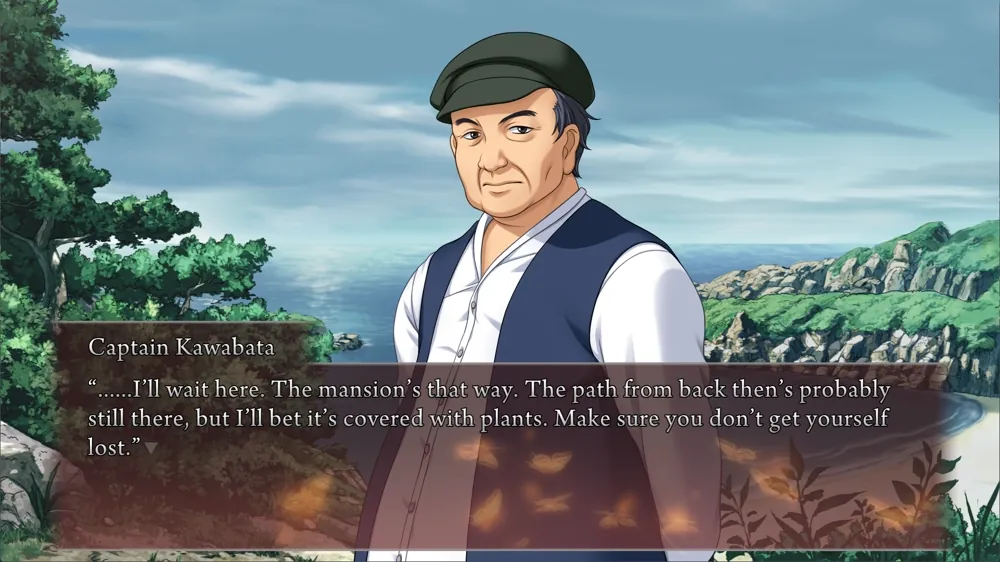
I don’t remember if we saw this shore background before.
Arriving at the shore, Ange tells Asakusa to wait with Kawabata at the boat. His ‘toxin’ will interfere with her intended ‘delivery’. He’s not sure what she means, but doesn’t ask. Well, she must intend to interact with the witches/ghosts then…
Proceeding through the forest, we get Ange’s thoughts about the ominous sense of Beatrice’s presence. We get some nice BGs of meadows and coastlines. Reaching a difficult rockslide, Ange deems it the border between 1986 and 1998: a point where if she went further, she could not herself return to the present. She addresses Mammon and Sakutarō:
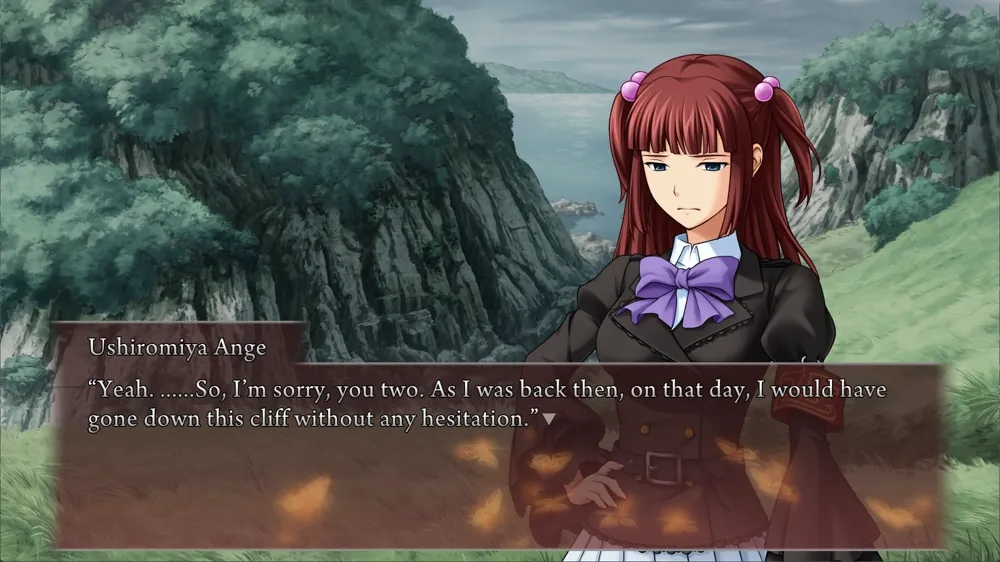
Ange waits for everyone to manifest (mentioning the non-family members with the rather startling phrase ‘those fun servants’.) She describes the final purpose of her journey: a journey to end things as the ‘final witch of Mariage Sorcière’. She describes her soul getting lifted by the wind to where her family are waiting. She first wants to address Maria, to talk about ‘just how much she had wounded her’.
Having understood magic, I now understand everything about the world Maria wanted to show me.
It is so warm, and overflowing with kindness and happiness.
……She had wanted to become even happier by sharing that world, but I had trampled it.
I was definitely using this incident as a template for imagining what Battler’s ‘sin’ might have been. Perhaps overextending that? After all, it would be a bit much if Battler did the exact same thing as Ange.
In any case, Ange says the line, about magic: without love, it cannot be seen. And after Ange ‘wounded’ Maria by rejecting her world of magic in chapter 8, Mariage Sorcière was ‘transfigured’ into something different than what Maria had wanted—something increasingly concerned with curses, venting Maria’s anger at her situation. Seems like a lot for Ange to blame herself for something she did as such a young child, but I guess she has been carrying this for years, and never had the opportunity to have a lasting relationship with Maria that would overwrite it—this was her very last conversation with her cousin.
(Notably, Ange does not mention any other person involved in Mariage Sorcière.)
OK, crazy thoughts time… I’m already throwing out all sorts of shit, but what if Battler and Ange are the same person? In some metaphysical sense, at least.
Sure, Bryn. How the fuck would that work? Ange was a six-year-old child at the time of the incident and we have no reason to believe that there was not an actual physical embodied six-year-old child, especially given the Ange storyline. But Ange’s betrayal of Maria seems to be presented as so foundational here…
No, wait, hmm. What if it’s like this?
- Battler rejects Rudolf, and Rudolf marries Kyrie. Ange is introduce to the island in Battler’s place. This is the ‘sin’?
- A very young Ange rejects and mocks Maria, kicking off the distortion of Mariage Sorcière.
- As a result of Ange’s action, things get really fucked up for Maria and the person who will eventually become Beatrice.
- Battler is to blame because if he hadn’t rejected Rudolf, Ange would never have come to the island.
I don’t think it really works, though. Battler is hardly responsible for Ange’s actions, and the far more significant culprits are like, Rosa, Kinzo and the rest making Maria and future-Beatrice’s lives miserable, not a child who was a jerk to another child one time.
OK, moving on. Ange flips through Maria’s diary/grimoire, observing the increasingly aggressive nature of the spells Maria describes.
Ange: “It was because I hurt you, Onee‐chan… that Mariage Sorcière ended up like this. ………You aren’t a black, evil witch. ……You were a white, ……pure, innocent, ……kind witch……”
‘Black’ (黒き) and ‘white’ (白き) are both present in the Japanese version of this line—notable because the idea of beneficial white magic and harmful black magic is new, I think? Though pretty common associations.
Alas, as much as I sympathise with Ange carrying this guilt over most of her life, she is overwriting the Maria that actually existed with her fantasy of a Maria as a saintly innocent person corrupted by her own cruelty—a narrative that makes Maria’s life revolve around Ange’s. That is not a way to remember someone. Maria’s dark fantasies and her other kindness are not in contradiction, they’re both part of her.
Poor Ange, though…
At that point, enter not the ghost of Maria… but Kasumi. Yeah, about time she caught up. Did she set up on Rokkenjima in advance and wait for Ange?
Ange concludes pretty quickly that Kasumi and her goons are here to kill her off. Lethal danger or no, it does not stop her from talking back…
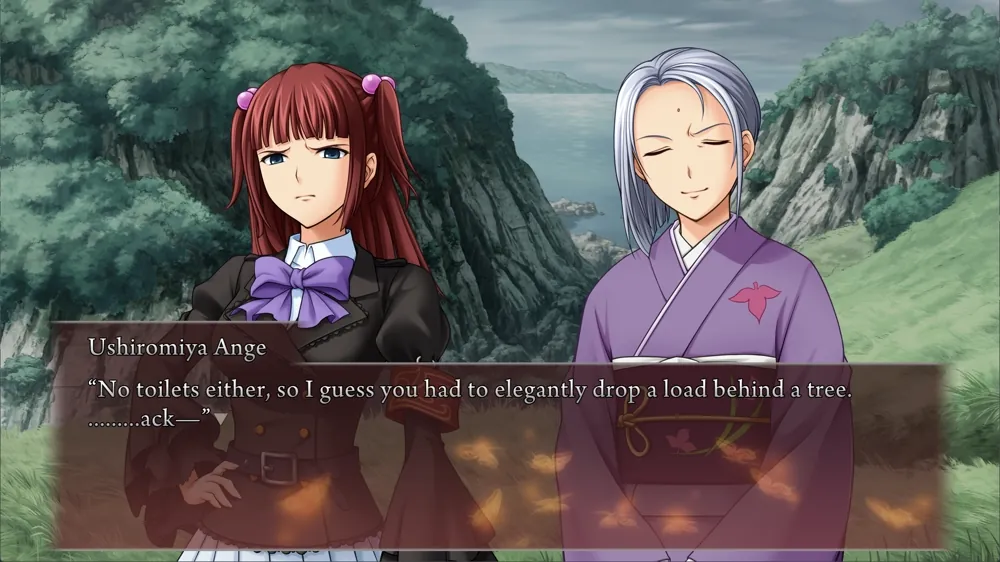
lmao get her
Kasumi retorts by literally grabbing her and spitting in her face! She insults Kyrie (clearly seeing Ange nothing more as an extension of Kyrie). Her criticisms, notably, parallel Beatrice’s criticism of Battler:
Kasumi: ……Unrestrained and irresponsible. ……She thought nothing of the long history and tradition of the Sumadera family, and selfishly flew out of the house. My entire life has been wiping up the messes she left behind…!
Ange has absolutely no fear of Kasumi, even as she gets kicked around. She disdainfully observes how Kumadera is still trapped in her childhood situation of being compared to Kasumi, and always will be.
Ange:“………When is your life going to begin? ……It’s never going to happen. You will continue to be sneered at by my dead mother, for ever and ever for all eternity until you die. ……In fact, why don’t you die? Why are you alive?”
Holy shit, Ange. I guess a lifetime of being belittled by Eva gives you a pretty incredible insult game. (Parallels, again, to Kinzo’s ‘tests’ and the ideal of self-mastery he went on about.)
Kasumi orders her goons to ‘make her some tea’, i.e. rough her up. God, she really loves this catchphrase. Her one entire character motif.
The narration notes that normally, the Sumadera family would straight up murder Kyrie and toss her in the ocean for doing something so beneath them as have an affair with a lesser house like the Ushiromiyas. But some backroom deal with the Ushiromiyas allowed her to get off with mere disinheritance… She says that on that day, Kyrie effectively ‘killed her’. (Which sounds like we should read it in light of Battler’s ‘death’ in 1980?) She blames Kyrie for all the demands the Sumadera family placed on her after she left.
Again, reading parallels in this with Battler. After Battler left the family, what did the rest of them do? (Or could I have been onto something with that ‘Battler took someone away’ theory after all?)
Anyway, Kasumi says, stealing the fortune from Ange would be a ritual that would allow her to move on from being tormented by Kyrie’s ghost. An twisted version of Ange’s purpose in coming to Rokkenjima!
As Mammon and Sakutarō intervene to tell Ange she should stop talking back and play along to look for an opening, she falls into a flashback into her many beatings in the name of the great Ushiromiya family. Sometimes Eva would forget the reasoning in the middle of her rant or beating, but still decide that there must have been a good reason!
Yes. Aunt Eva’s punishments weren’t something that would continue until I learned something, or acknowledged my mistake, or apologized. ………They would continue until Aunt Eva wanted to stop.
Very crucial observation right there…
Ange contemplates the cycle of abuse: how Eva, and Rosa, must have gone through the same thing she inflicted on Ange. Maria’s ‘magic’, she concludes, is a way to break out from the chain of suffering. If Maria had had children, Ange imagines, she would not have abused them in the way Rosa abused her. And so, she imagines responding to Eva’s abuses not by snapping back, but by recognising Eva’s own suffering. She imagines Eva being taught an evil magic by Beatrice, just as Maria was taught such after Sakutarō’s death.
Perhaps, Ange considers, she could somehow have become Eva’s only confidante. (Once again: you’re putting some pretty insane pressure on your six-your-old self here, Ange!) The one who deserves her hatred, Ange concludes, is not Eva herself, but the ‘black witch’ who taught her to relieve her suffering by inflicting it on others—illustrated in this instance by the Eva Beatrice sprite. And Ange concludes she had failed in her own duty to be a ‘white witch’ to relieve her suffering.
Breaking my heart here, Ange. That’s too much weight to bear. Alas, Ange is evidently one of those people who sees every bad thing in the universe as her own personal failing. Unfortunately… I can relate, and I can see so many other people carrying that ‘witch’ of their own.
Now she’s able to view Eva with love, Ange concludes she can ‘see the black witch’, which is drawn as Eva Beatrice.
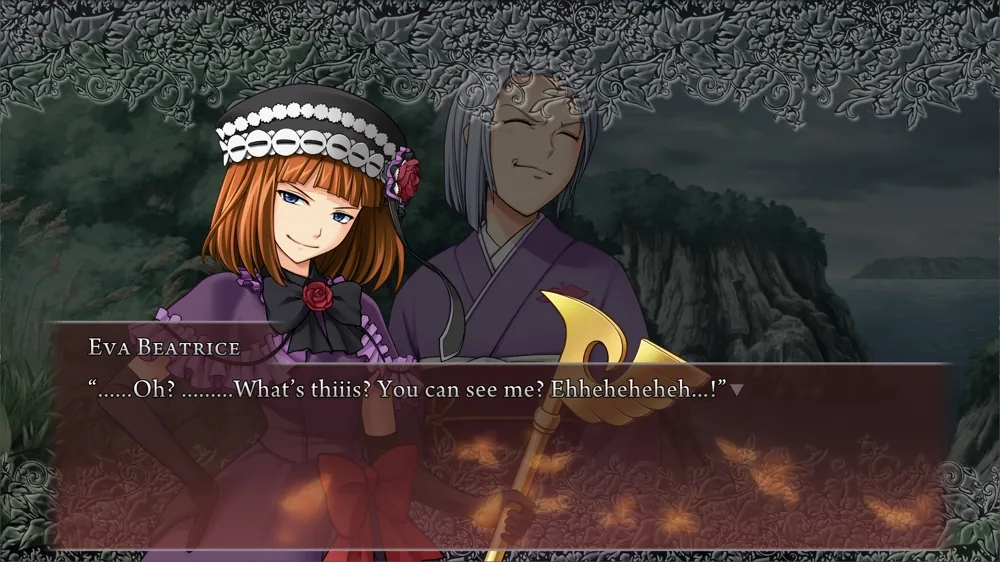
She tells Eva Beatrice she won’t hate her (lest she perpetuate the hatred). She just finds her sad. This doesn’t seem to much impress EB!
This is all making me think about the depiction of characters undergoing torture and execution in traditional fiction, political propaganda etc. For a heroic character, the usual depiction is to have them bear their odeal stoically, maybe groaning in pain but still able to look on their captors with pity or contempt. Even though they are physically on the losing side, morally they show they are still showing themselves to be superior through their composure and commitment. Meanwhile, for a character the narrative looks down on, such as a villain, they will obviously be afraid, try to make bargains, beg for help etc. Being able to stay cool under torture is a symbol of virtue.
In reality, of course, I think the truth is generally that people undergoing torture will say whatever they guess they need to say to get their captor to stop. The torture context tends to obliterate everything else. But fictional characters are larger than life and they can bear things that would reduce most people to a sobbing wreck.
Then again, Ange is spending her torture imagining an evil witch ordering Kasumi to do all sorts of deranged things, so maybe she’s not bearing up all that well after all…
Since Ange is not responding to the provocations anymore, Eva Beatrice escalates. She suggests to Kasumi to take Maria’s diary. That’s how you’ll get her, Kasumi! Make fun of a dead six-year-old. That’ll show her.
[A brief linguistic note: Eva Beatrice has a catchphrase that goes like ‘why don’t you just _ forever’, e.g. ‘hate me with all your strength forever’. This vocal tic appears to represent phrases like 憎んじゃえばぁッ nikunjyaebaa, which if I’m understanding the grammar right, uses the auxilary verb ちゃう (to do completely) in its conditional (-eba) form, which is usually used to express ‘if-then’ type expressions, and sometimes she trails off on the -a at the end. Not an easy construct to translate into English. I think in more usual speech, ‘why don’t you x’ would be rendered something like 「ⅹたら」. Here, gramatically I think it’s more like ‘if you were to completely hate me forever…’, with the consequent omitted. That doesn’t work as a taunt in English, though!]
Taking the diary is enough to break through Ange’s composure. One thing that Umineko certainly does understand is that you can only turn the other cheek for so long when someone is searching for whatever will hurt you the most.
Kasumi interprets the diary as Ange’s own, and mocks her for her supposed interest in magical girls from anime. The translators turn 痛い (itai) into ‘cringe’, which feels like an interestingly modern translation! (When did we start simply using ‘cringe’ as an adjective that can be stated as a single-word sentence anyway? As opposed to something like ‘how cringey’. I wonder when this translation was written. The git commit is in 2019, but the translation project must predate that.)
Of course the symbolic desecration escalates into physically destroying the pages of the book. At some point, Kasumi gets to the page on ‘magic friends’ (魔法の友達). The ‘denying toxin’ burns at Ange’s image of Mammon. Eva Beatrice acts like she can tell Kasumi which page to turn to, of course this world we’re seeing is Ange’s inner drama, not hers. In that light… in giving an image to Eva Beatrice, Ange’s mind is able to generate far crueller and more specific thoughts than Kasumi would be able to cook up on her own.
So Sakutarō gets torn yet again. Damn, this guy basically exists to suffer.
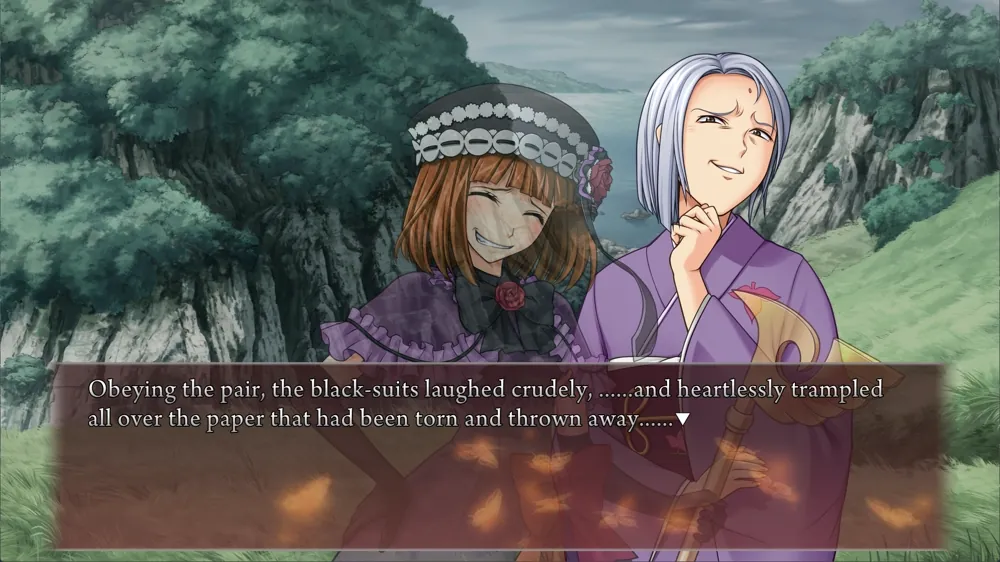
There is something weirdly comical about these black-suited armed goons being ordered to assist in bullying a teenage girl in this incredibly petty way. Like, I guess the incongruity is part of the point of this line: despite all the trappings of spy drama, this is fundamentally a reprise of the schoolyard bullying scene.
Kasumi calls Ange—indirectly, Maria—a true かわいそう (kawaisou), a pathetic thing. (Don’t confuse this with the usual meaning of kawaii meaning cute, in this context it is calling something pitiful.)
Finally, Kasumi turns to a page containing a simple spell to ‘always be friends with mama, who I love’. And that spell is…
Oh, shit. That spell is of course ‘Uu-uu’.
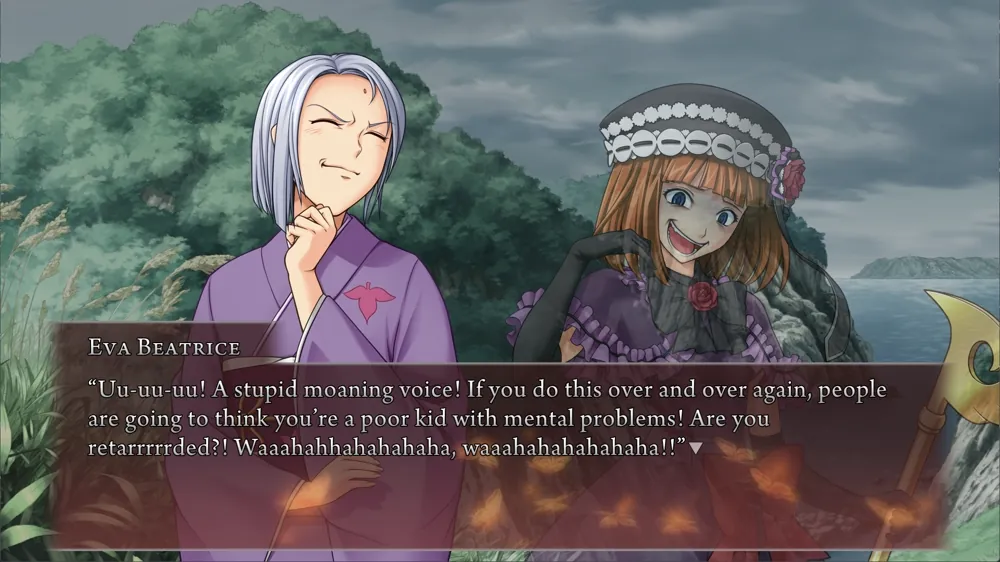
Probably the most contextually appropriate translation of ‘baka’ as ‘retarded’ I’ve seen. Exactly the word she’d use in English.
We get the story behind ‘uu-uu’—a happy picnic with Maria and Rosa, which Maria held onto in hard times.
EB rounds on the idea of happiness as a result of anything other than externalising pain of cruelty, the magic of ‘black witches’ like her. She mocks the idea that Ange might show her some magic. So Ange stands up… and the soundtrack shifts. What exactly is she gonna do?
Ange opens her eyes, and ‘a great wind arises’. She calls on the seven sisters of purgatory, and with an ahaha.wav, they manifest.
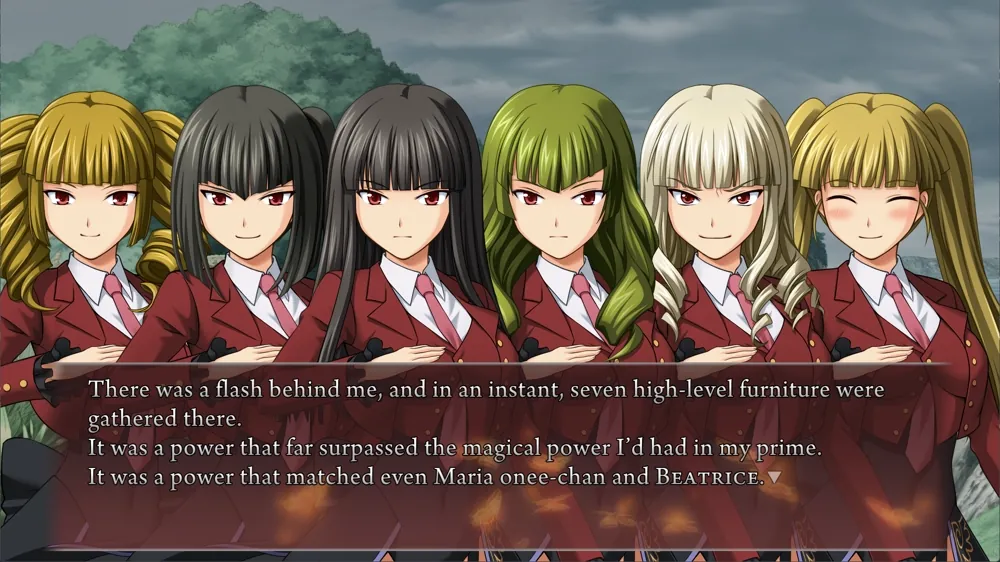
So… hmm, I’m going to hold off on contemplating on the metaphysical implications of this until it plays out. Ange says the difference, compared to the last time she failed to call on magic, is that this time she has magical power and resolve; that her purpose this time is not a ‘cheap emotion’. She’s going to protect Mariage Sorcière. The Seven Sisters have not manifested on the physical plane, it seems, but they can… go after Eva Beatrice? Hmm. Ange simply instructs them to believe. Can you use magical entities to believe in magic and get more magic? Sounds like something of an ‘infinite wishes’ trick.
Kasumi is apparently done playing and has one of her goons pull a gun. So it’s a pretty direct test! Who are these guys anyway? They don’t seem to have any compunctions about gunning down an unarmed 18 year old. The voice acting is very the stereotypical ‘yakuza tough guy accent’.
So the guy shoots, and the narration says a shot rings out and blood flies, and then it appears (appears) that Lucifer intercepted the bullet while Leviathan killed the goon. If we can believe this scene, Ange’s done the impossible and overcome the antimagic toxin, manifesting spells in front of nonbelievers. Tho it seems that they still can’t see the Sisters of Purgatory.
(It’s interesting that all the discussion of nefarious black magic that’s used to harm and good white magic that’s used to kill, Ange’s demonstration of magic power is straight up killing someone with a spell. In self-defence, yes! But still a violent use of magic.)
So the Sisters take out the goons one by one, making holes in various places. Chest, chest, eye, head, guts, head—look, I’m just checking if this qualifies as the resurrection ritual! That would be something.
Obviously if we want a mundane interpretation, we could assume that Asakusa is somewhere out of sight with a sniper rifle, taking out the goons one by one. (Amusingly, ‘magic doesn’t exist’ is now being declared by actual witch Eva Beatrice.)
The narration incidentally notes that at this time, the Seven Sisters have gone from ‘high-level furniture’ to ‘the level of weapons’, so they’re now higher-tier on the whole magical entity tier list.
So, after massacring the goons (who are basically not people I guess), Ange offers Kasumi the option of having the ‘hole in her heart’ filled—so long as she just believes in magic. Of course, no villain worth their salt ever takes last-minute mercy from the protagonist. Kasumi doesn’t take well to this high-stakes battle therapy…
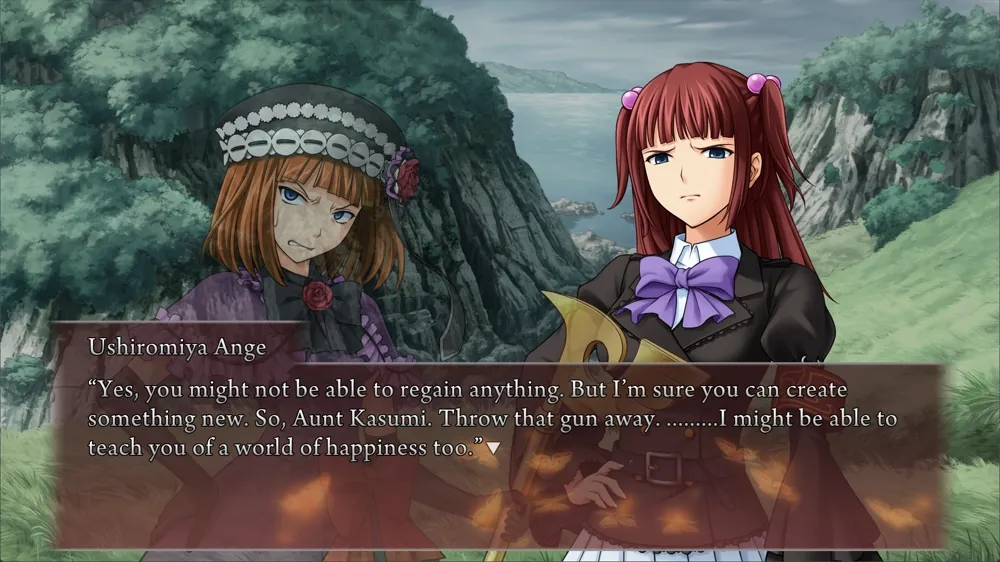
Kasumi retorts by pointing out that her ordeal essentially amounted to straight-up marital rape, backed by her family who ordered her to abandon her partner and take the arranged marriage that Kyrie refused. (The rape is pretty explicit: she says “How do you imagine I felt consummating the marriage?”). She can’t get revenge on dead Kyrie, so she can take it out on Ange.
Well, she’s too far gone, concludes extremely zoomed in Ange. I guess she just has to die:
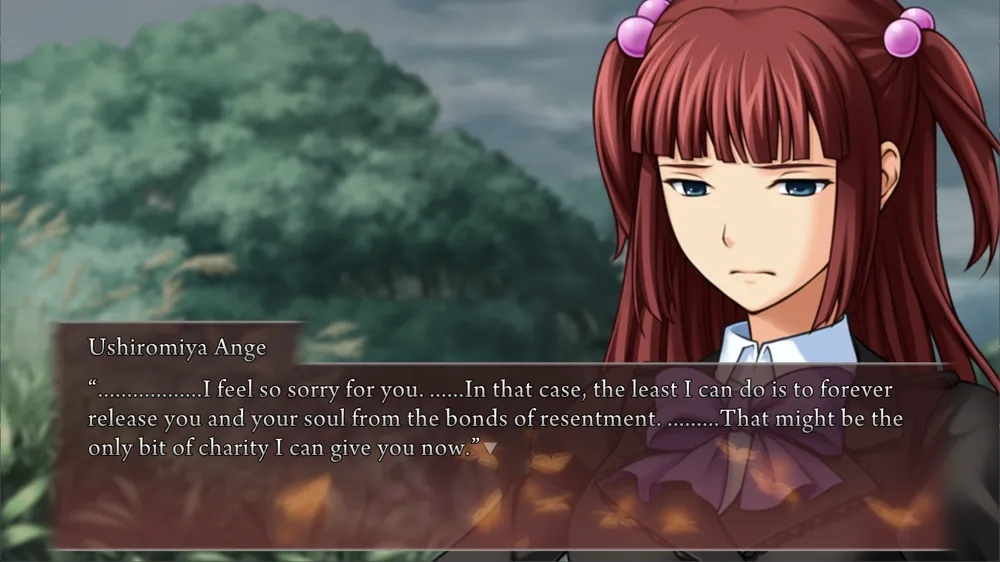
And of course, it would be Mammon to take the final kill.
So that just leaves Eva Beatrice. Who has something more interesting to say…
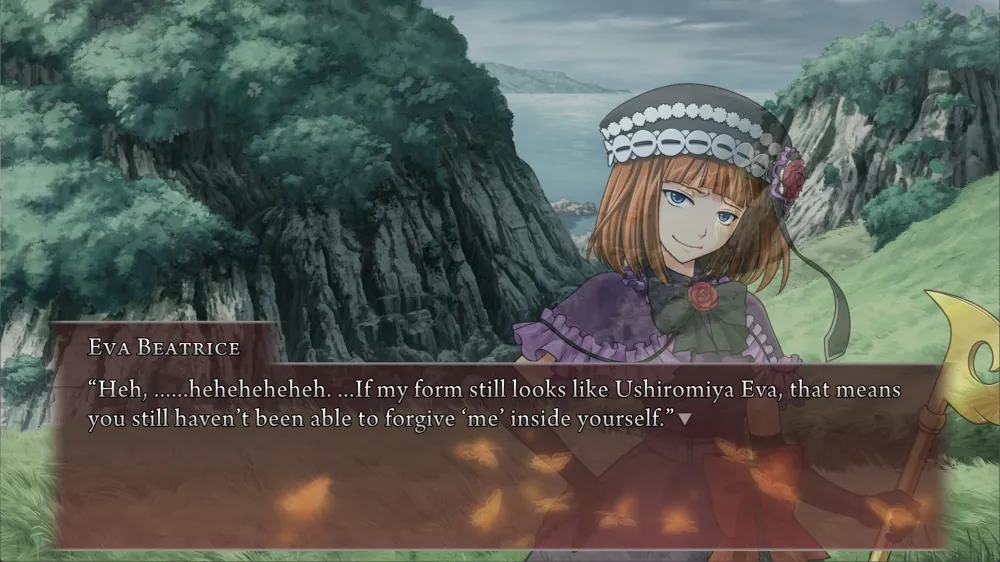
Which is a fair point. For all this big talk of forgiveness and recognising the reasons for things, Ange still identifies one ontologically evil figure in her worldview.
So, Eva Beatrice says, she has her own magic to show. She becomes…
That woman you hated and despised the most!
And that woman hated and despised you the most as well…!
So she becomes Eva! With the gun! ‘Returned from hell to kill you!’ she declares. She speaks of how black magic made her work hard and persist, in contrast to ‘escapist magic’. Coming back like this is a ‘black magic miracle’ to contest against Ange’s ‘white magic miracle’ of killing a whole bunch of people. OK, sure…
Eva declares that Ange is now immersed in the toxin and won’t be able to summon the Sisters. Is that… a thing she’s allowed to do? I thought the toxin was a natural manifestation of unbelief. Anyway, Eva and Ange engage in a few rounds ‘yes it is’, ‘no it isn’t’ as to whether this should negate Ange’s magic.
Eva tries to fire… and her gun explodes! Mammon made it through the ‘toxin’ after all. I feel like this is less impressive than killing all those real-life guys though, since Eva emerging from Hell with a shotgun is very definitely Magic Plane stuff, even if Eva is somehow able to release a huge cloud of toxin that only affects Ange.
Having handily dispatched all her enemies, Eva thanks Mammon for being good furniture and apologises for doubting her. (God, Ange. That is almost as bad as that time I stole a pokémon card from another child.)
I will give Ange one thing: she does the fucking, random English phrase thing to give Eva a sendoff…
Ange: “……Aunt Eva. Thank you for sticking with me until today. This is farewell. <Have a nice dream>. <See you in hell>.”
Eva: <Cool.>
And suddenly we are back with Bernkastel, at the beginning of Ange’s journey.
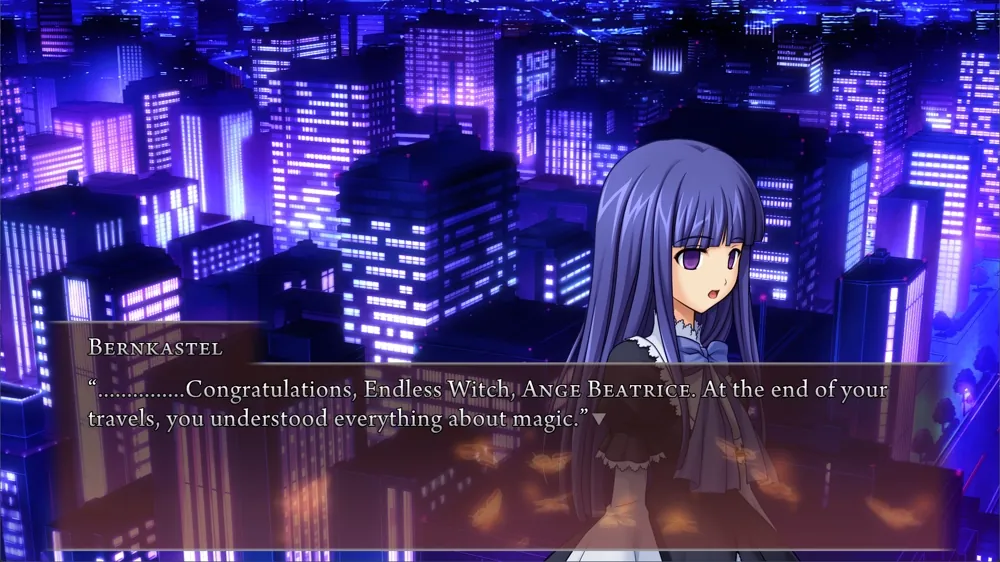
Ange acknowledges this: she inherited the world created by Mariage Sorcière. And with this new understanding, she came to understand that marriage is born out of love, sadness and anger.
Ange: ………And that’s why, honestly, I wish I could leave that world of hers alone. ……After all, in her eyes at least, that world is complete as it is.
Bernkastel: …………But then you’d have to give up on your family.
Ange: ………………… ……That’s right. So, although I feel bad about it, I have to fight.
So, despite the lesson of the whole episode being the explication of “without love, it cannot be seen”… Ange resolves that in this case, she cannot have compassion. She must ‘make her heart a demon’.
They discuss the fact that 1998!Ange will not get to meet her family, even if she succeeds in overcoming Beatrice. Ange says that thanks to Bernkastel, she has learned how to bring her family back—knowledge which Bernkastel says even she doesn’t have, as another sort of witch who has reached ‘another place’.
Ange declares she is a piece, not a player—and as such, though she will give her blessing to Beatrice should she lose, she will fight as ruthlessly and optimally as she can as a piece—for the sake of getting Battler back. That she has that right. And it’s finally time to make her move.
The next chapter is titled ‘Ushiromiya Ange’.
end comments
So what to make of all this?
OK, so first up, I was taking totally the wrong frame to consider this return to Rokkenjima. I was so caught up in trying to unpick the mystery that I didn’t consider how this chapter would factor into Ange’s character arc. Of course, Ange must achieve her personal resolution, and the theme of her story in this episode has been all about understanding the nature of magic as understood by Umineko. So, although we got a few tidbits about Kuwadorian and the timeline, this is not a chapter to comb for clues.
Instead, we got what can be decisively be called a ‘Magic Scene’ in Ange’s timeline. At this point, the bounds of the game are becoming rather unclear. Is the ‘Ange arc’ part of the game being played between Beatrice and Battler, where we must explain away its mysteries with a theory like ‘Asakusa shot those guys’? It doesn’t feel like it should be.
It all comes back, it seems, to the magic circle.
On the magic circle
I mentioned this in passing last chapter, but it seems increasingly relevant to the game. The concept of the ‘magic circle’ was originally coined* in Homo Ludens by Huizinga, in this passage:
More striking even than the limitation as to time is the limitation as to space. All play moves and has its being within a play-ground marked off beforehand either materially or ideally, deliberately or as a matter of course. Just as there is no formal difference between play and ritual, so the ‘consecrated spot’ cannot be formally distinguished from the play-ground. The arena, the card-table, the magic circle, the temple, the stage, the screen, the tennis court, the court of justice, etc, are all in form and function play-grounds, i.e. forbidden spots, isolated, hedged round, hallowed, within which special rules obtain. All are temporary worlds within the ordinary world, dedicated to the performance of an act apart.
In the paragraph immediately before, Huizinga also observes how play quickly takes on the character of tradition, as the procedures of a game become encoded as repeated rituals. This leads straight into the discussion of the spoilsport from last chapter.
*The idea of the magic circle was picked up by Eric Zimmermann, Frank Latz and Katie Salen nearly 60 years later, where it became a central concept to the academic field of ludology explicated in books like Rules of Play, albeit somewhat controversially. I learned about it in detail after Wikipedia directed me to this 2010 article by Zimmermann for Gamasutra, in which he says that he and Salen elaborated heavily on Huizinga’s brief description to create the 2000s iteration of the concept, and laments how a narrow version of has been treated as a dogma to overcome by subsequent scholars.
The idea of the magic circle is that a game establishes a special sub-‘world’ where different rules apply compared to everyday life. Players observe certain rituals to enter into the state of ‘playing the game’, and while the game continues to hold, acts that would not have meaning otherwise (like kicking a rubber ball into a metal rectangle) take on meanings and encode the state of this abstract system. In the years since becoming a game developer, I’ve become increasing fascinated with this area of philosophy—particularly, the systems that we use to define what ‘counts’.
Now, there is something perverse in using the metaphor of the ‘magic circle’ used to analyse games to come back and analyse, well, magic… but I think games are very relevant to the discussion of magic, at least as an actual human practice. (See also: the discussion of magic in Baru Cormorant I wrote back in 2020, ‘everything is roleplaying’ from last year, and the what’s the book for series discussing the nature of TTRPGs… this is a favourite topic!)
So, the magic circle. To me one of the most fascinating things about the magic circle is that it is unclear exactly where its boundary lies—for it is of course a constantly enacted process, not a one-and-done thing.
For the duration of a game, the players participate in an act of mutual creation of that special world… but they’re not unaware of the ‘outside’ world. The game may be interrupted, and later they are able to mutually decide how to get it back on track. And while games often have formal systems of rules—the voluntary obstacles famously described by Bernard Suits—everything about games is fuzzy. There is considerable latitude to decide from lots of possibilities of what could be part of the game. If your group realises partway through that you’ve made a mistake in interpreting the rules of a board game, you can come up with a ruling on the fly to keep the game going, taking into account the spirit of the game. If you look at the written rules that accrue around any popular organised sport, you realise how much complexity of interpretation is brushed over when players get together to move a ball about.
The boundaries of a game can even move unexpectedly. When computer chess engines surpassed every human player, it became part of the rules of chess that a player who used a computer chess engine to decide what move to make during the game would be cheating, but exploring possible plays with a computer chess engine prior to a match was fair game and indeed soon became the expected practice. Prior to this, I assume it was also against the rules to consult with another player about which move to make. So, certain ways of choosing a move are acceptable, others are not, and exactly which is which is a matter decided by an evolving play culture.
So, magic then. The history of magic is full of esoteric societies, full of rules, rituals, ranks, symbols and so on that seem opaque and incomprehensible to outsiders. The same is true of its close cousin, religious organisations. The endless silly hats of Catholicism are objects holding a type of state within that system, much like the pieces of a chessboard. The same goes for a judge’s wig, and their seat at the head of a courtroom. The scout’s badge, the leatherdyke’s cap: these objects aren’t valuable of themselves, but because of the state they represent inside a specific context.
And these contexts all own a magic circle, whether their seen as ‘serious’ or ‘frivolous’ by the players. The law in particular has rules and gambits as intricate as any game played by humans, and literally the whole ‘game’ is about arguing about which of its many rules should apply in a given situation.
Following Wittgenstein we might end up saying all linguistic utterances are part of such games, having meaning only relative to the system they’re embedded in.
But not all such magic circles are so all-encompassing. Perhaps each relationship, each group of friends, might have its own magic circle: a history assembled from little pieces of interaction, habits and injokes and so on. After all, ultimately all we’re talking about is a system of special modes of interaction that have meaning just for those people, and not for others who have not ‘entered the circle’.
Returning to the magic circle and the spoilsport, a player who cheats at chess is still respecting the existence of chess. A person who swept the board off the table and told the players to get dinner is doing something quite different, scrubbing away the magic circle and the world it represents, at least for a time.
What if a person approaches the chess players, mocks them all as big nerds, and stamps and kicks on the chess pieces? Well, that person would be not just working to destroy that game, but discourage any future game. If they did it with enough dedication, the game of chess may cease to be played.
A game like chess has plenty of cultural cachet to protect it. The same is not true for a small, private game shared between two people. Their shared world is intensely vulnerable. The context that holds the meanings shared between them could dissolve, and then those meanings will be lost.
Of course, actions motivated by the logic interior to a magic circle can reach out of it. A football might fly out of the field. In-character feelings can famously ‘bleed’ for roleplayers. A gambler can be ruined. And, of course, if two armies go to war, motivated by a conceptual space that holds ideas such as ‘countries’ and a ‘casus belli’, the bombs will surely rain down on people who have no awareness or understanding of the logic that motivated their death. In Carol Cohn’s classic article sex and death in the rational world of defense intellectuals, she could be said to be probing the ‘magic circle’ of nuclear defense, and trying to understand the alien mindset of the players deeply immersed in the ‘game’ poised to end human society altogether. (An analogy famously explored in the 80s film War Games.)
Now, suppose all the players of a game are abruptly killed. This is what has happened in Umineko. Their private inner worlds, the magic circles they share in, would be obliterated. Whatever significance they had in life, whether those ‘games’ would linger or dissipate or evolve into something new as the players aged… and for the survivors, the memory of the game is one of the only things they have to preserve those people.
(This is also something I do not need to imagine. When my friend Fall passed away, I learned of all the intricate notes she took on all sorts of subjects; I heard about her interest in Taoism, her experiences with drugs… there was a great deal in her life that I never got invited into. At that point, it felt absolutely imperative to preserve what fragments she left behind, like a website she made once. And indeed, we did share a number of ‘magic circles’: games we played, the group where we watched anime. Things that were important to her, like the Japanese language, took on a profound importance and motivated me to start learning more seriously. My mental version of Fall is, and forever will be, a language nerd and a skilled Japanese translator. Perhaps this would indeed have remained a central part of her life, but it’s a tough industry in which she struggled a lot, so had she lived, who knows whether that would always have been true?)
So, finally returning to Umineko…
When Maria died, what Ange had to remember her was her interest in her idea of witches: the ‘Mariage Sorcière’ and the way she used it to structure her life. At that point, Maria’s life is frozen; she will never accumulate new experiences, there will be no 1987!Maria. All Ange has of her is the contents of the ‘magic circle’ that Maria (and ‘Beatrice’) created.
The same logic, then, presumably applies to Beatrice. To understand her actions (or her stories, in the case of author!Beatrice), it is not sufficient to flip the chessboard; it is necessary to understand what game she is even playing. And it seems rather like she was also involved in the Mariage Sorcière game; that this game, once shared with Maria, was perhaps what author!Beatrice used to structure the stories she tells to process the Rokkenjima incident.
And, to enter the magic circle, we must join her game. The reason for the whole roundabout presentation through the game against Battler is, perhaps, to get us into the mindset of Beatrice.
In short: this game is not primarily a whodunnit or a howdunnit, it’s a whydunnit. And a proper account of whydunnit requires us to fully understand the warped insides of the ‘magic circle’ that held around Rokkenjima—and then perhaps deconstruct and reconstruct it into something that can allow life to continue?
Battler’s task—or if Battler is truly out of the game now, Ange’s task, or any other player’s task—is not simply to explain how various crimes could have been accomplished by mundane means. It is to understand how a system of magical concepts could arise in the first place. So, we can suppose: the convoluted moves in Beatrice’s games so far are not merely to confound and confuse Battler, they have a longer-term purpose: to lay the groundwork that we can understand why the Rokkenjima massacre actually happened.
How then to interpret character!Beatrice abandoning the game against Battler and proving that Battler couldn’t even be real? Why would author!Beatrice (or Ryuukishi07!) write a version of Battler like this, strangely unaware of his own history? And why would character!Beatrice confront him with it?
I need to catch up on work lmao so I think I will have to leave this line of questioning for now. Perhaps the next chapter will shed some light!
Comments